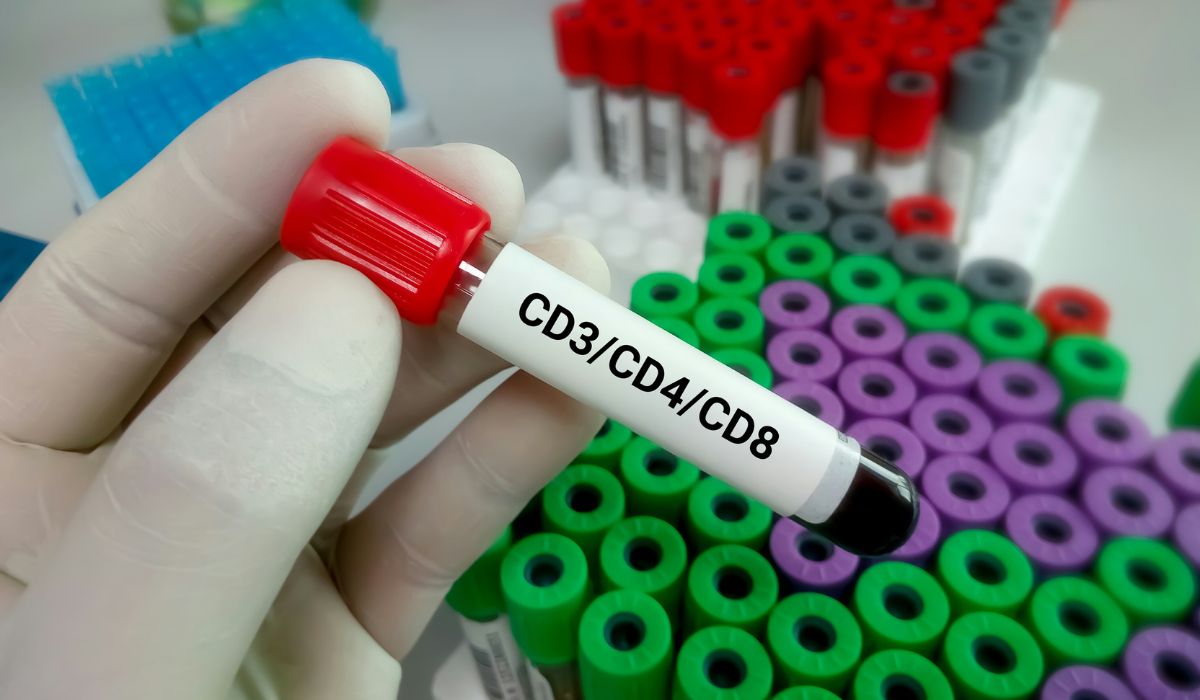T cell

What is a CD3/CD4/CD8 Cell Count test?
A CD3/CD4/CD8 Cell Count test is a measurement of CD3/CD4/CD8 levels in the bloodstream, which are CDs that are specific to cells in the adaptive immune response, such as B cells that produce antibodies or T cells that act as memory units. These cells are important for building immunity in the body.
Get to know CD3/CD4/CD8
Cells that function in the immune system are derived from stem cells located in the bone marrow and come in various types. However, CD3/CD4/CD8 are associated with small white blood cells called lymphocytes, which are divided into B cells and T cells.
B cells function in producing a type of fluid immunity called antibodies. B cells are stimulated by antigens and then transform into plasma cells to create antibodies that are specific to that antigen.
T cells are responsible for cell-mediated responses to eliminate foreign substances or microorganisms. They are divided into CD4 cells and CD8 cells.

Functions of CD4+ and CD8+ cells
What are CD4 cells?
CD4 cells, also known as helper T (Th) cells, are white blood cells with the CD4 antigen on their cell surface. They play a crucial role in promoting the production of specific antibodies by B cells and the activation of T cells to become cytotoxic T cells (CTLs). Therefore, CD4 cells are essential for enhancing the immune system's response.
What are CD8 cells?
CD8 cells, also known as killer cells, are white blood cells with the CD8 antigen on their cell surface. Their function is to destroy cells that are abnormal or infected with pathogens. These cells can recognize foreign cells because they lack the HLA class I molecule, which is present on normal white blood cells. CD8 cells play a crucial role in stimulating the immune system's response to specific antigens.
Stimulate B Cells to create antibodies.
B cells capture specific antibodies using antibody receptors. Both B and T cells have molecular receptors on their cell surface to bind with antigens. For B cells, this is an immunoglobulin molecule that adheres to the cell surface. For T cells, it is the T-cell receptor (TCR) or CD3, which is a more complex molecule that can recognize and bind to a wide variety of antigens presented only by antigen-presenting cells.
After the antibody receptor brings the antigen part into the cell and transforms at the cell surface together with the HLA Class II molecule, it allows the T helper cell to bind and be stimulated by the antibody from B cells. Subsequently, the T cell releases lymphokines that instruct the B cell to transform into a plasma cell to produce antibodies further.
Regulatory T Cell ( Treg Cell )
Regulatory T cells (Treg cells) are a subset of white blood cells that fall under the category of T lymphocytes. They can be divided into two groups: CD4+ Treg cells and CD8+ Treg cells. Their role is to maintain the balance of the immune system within the body by preventing T cells that recognize the body’s own cells from damaging the body’s cells. Additionally, they protect the fetus from being harmed by the mother’s immune system and inhibit the activity of white blood cells that are overly sensitive to foreign substances, which can cause allergies or asthma.
Why do we have to check TREG CELL COUNT?
In the body, Treg cells vary in number. Specifically, CD4+ Treg cells make up about 5-10% of all CD4+ white blood cells, and CD8+ Treg cells constitute about 0.1-1% of all CD8+ white blood cells. The number of both types of Treg cells in the body can indicate the risk of diseases related to the immune system and cancer.
- A decrease in the number of Treg cells can result in insufficient ability to prevent white blood cells from attacking the body’s own cells, leading to autoimmune diseases. Additionally, a lack of Treg cells can lead to an inability to suppress the activity of other immune cells, resulting in allergic reactions or the development of allergic diseases.
- An increase in the number of Treg cells can indicate a higher risk of cancer and viral infections such as hepatitis B virus (HBV), hepatitis C virus (HCV), HIV, and herpes simplex virus, which causes herpes. This is because Treg cells can help cancer cells or viruses evade the immune system, resulting in the inability of the immune cells to destroy the cancer cells or infected cells.

The diagram above demonstrates the interaction of different cells in the body’s immune system when cancer cells are detected. Cells responsible for presenting foreign particles, such as dendritic cells or macrophages, present parts of the cancer cells to Treg cells. Then, Treg cells inhibit the function of T cells, resulting in the inability of T cells to eliminate the cancer cells.
Who should undergo Regulatory T Cell (Treg Cell) count testing in the body?
- Individuals with family members or relatives who have a history of autoimmune diseases, such as Systemic Lupus Erythematosus (SLE).
- Individuals who are undergoing treatment for conditions related to autoimmune diseases.
- Individuals who are undergoing treatment for allergic diseases.
- Individuals who are undergoing cancer treatment.
- Individuals with viral infections, which reflect a state of immunodeficiency.
- Individuals with chronic diseases, such as liver disease, diabetes, and high blood cholesterol.
- Individuals with insufficient rest, high stress levels, lack of physical exercise, and health issues.
- Individuals with malnutrition due to imbalanced diets, such as insufficient consumption of vegetables or fruits.
How to increase your immune level In cases where the number of Treg Cells is below the standard
- Consult a doctor to identify risk factors for autoimmune diseases and cancer.
- Using dietary supplements that help boost the body’s immune system.
- Adjusting dietary habits to include foods rich in antioxidants, or taking vitamin supplements, especially vitamin A.
- Engaging in appropriate and sufficient exercise, especially in the morning, to allow the body to receive more vitamin D.
- Adjust your lifestyle to achieve a balance between work and rest.
